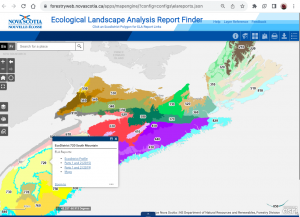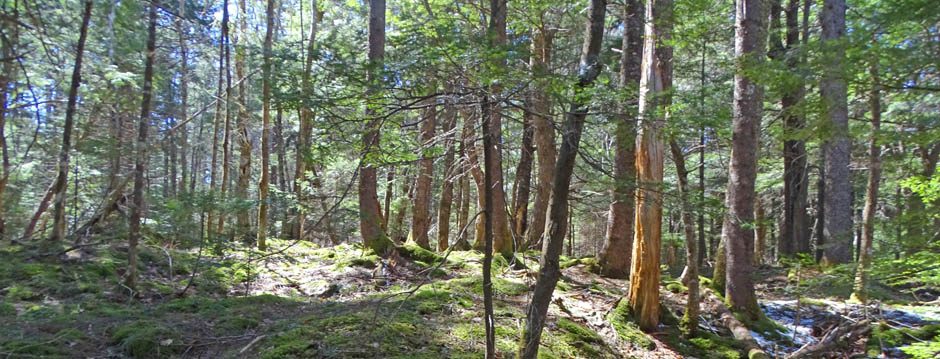New page, created Nov 9, 2023. To cite NS Gov Docs most pertinent to implementation of the TRIAD (drafting)
Collaborative Protected Areas Strategy
NS Government, Dec 2023. “Currently, 13.45 per cent of Nova Scotia is protected or conserved. O… We will identify, protect, and manage provincially administered lands and
inland waters by identifying lands to support achieving 15 per cent by 2026 and 20 per cent by 2030.”
High Production Forestry in Nova Scotia: Phase 2 Guidance for Implementation
NS Gov Jan 2023 “One zone of the triad model is the high production forest zone where timber production is the priority to support the forest products sector and provincial economy. This document reviews steps taken to develop government’s approach to this zone and outlines key directions for implementation, effective January 17, 2023.” The document cites an online high production forestry map.
Silvicultural Guide for the Ecological Matrix (SGEM)
“The Silviculture Guide for the Ecological Matrix (SGEM) outlines the types of forest practices that can be used within matrix areas on Crown lands. The triad model prioritizes biodiversity conservation through lower impact forestry and reduces clearcutting where this guide is applied.”
Old-growth Forest Policy
Old-growth forests are now included in the conservation zones. Government has updated the policy that identifies and protects old-growth forests on Crown land. The new policy is incorporated into the harvest management approvals process.
Supporting Research
A review of natural disturbances to inform implementation of
ecological forestry in Nova Scotia, Canada (PDF)
Taylor et al., 2020. Environ. Rev. 28: 387–414 Link is to full, publicly available PDF
Natural disturbance regimes for implementation of ecological
forestry: a review and case study from Nova Scotia, Canada (PDF)
McLean et al., 2021 in Environmental Reviews
—————–
There are more documents, descriptions of projects etc on the governments Ecological Forestry webpage. However, it has not been kept up to date in regard to the status of some of the projects, e.g., the Environmental Assessment project which, apparently, has been dropped – and with it, most of the public transparency/engagement around implementation of the Triad as recommended in the
A review of forestry practices in Nova Scotia (2018) (aka “The Lahey Report” of 2018)
(Also view: Addendum (2018)
On Nov 30, 2021, Prof Lahey released a review of progress on the implementation of his recommendations:
–Independent Evaluation of Implementation of the Forest Practices Report for Nova Scotia (PDF)
– Attachments to the Independent Evaluation of Implementation of the Forest Practices Report for Nova Scotia
Forest conservation through protection of old growth: the case of Nova Scotia
Peter N. Duinker1*, Peter G. Bush2, John C. Brazner3, Mark C. MacPhail4, Bruce J. Stewart2, Emily K. Woudstra5. 2023. THE FORESTRY CHRONICLE, VOL. 99, No 2 —
1School for Resource and Environmental Studies, Dalhousie University, Halifax, NS B3H 4R2; *Corresponding author: peter.duinker@dal.ca////2Forestry Division, Department of Natural Resources and Renewables, 15 Arlington Place, Truro, NS B2N 0G9//// 3Wildlife Division, Department of Natural Resources and Renewables, 136 Exhibition Street, Kentville, NS B4N 4E5////4Regional Services Division, Department of Natural Resources and Renewables, 300 Mountain Road, Sydney, NS B1L 1A9//// 5Fleet and Forest Protection Division, Department of Natural Resources and Renewables, 23 Creighton Rd., East Shubenacadie, NS B0N 2H0
ABSTRACT Old-growth forests are both rare and special ecosystems across most of the world. Policies to protect and possibly enhance and increase them are plentiful and diverse across nations and sub-national jurisdictions. Nova Scotia has had a policy on conservation of old-growth forests on public lands in the province since 1999. The second such policy dated 2012 was recently replaced by a revised policy in 2022. After presenting knowledge based on selected scientific literature about old-growth forests in Nova Scotia, the paper describes the improvements made in the 2022 policy. These include: (a) a more-nuanced set of operational definitions; (b) a commitment to protect all old-growth forest on public lands, whether currently identified or not; (c) robust replacement provisions in the rare event that the provincial government chooses to allow provincially significant infrastructure to be built on public land supporting old-growth forest; and (d) a renewed commitment to work with private landowners on their aspirations to conserve old-growth forest. The new policy, adopted in August 2022, also contains a commitment to a public review and possible renewal by August 2027.
COMMENT. The self-congratulatory company Line, not to be confused with an independent review.
 Ecological Landscape Analysis Reports
Ecological Landscape Analysis Reports
Interactive map. When you zero in on a Ecodistrict, links to pertinent PDFs are given.
